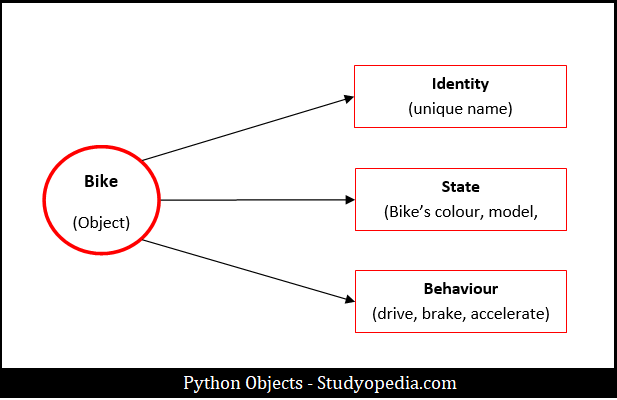22 Feb Python Classes and Objects
Python is an interpreted high-level, structural, and object-oriented programming language. Since it is object-oriented, the concept of classes and objects is well-discussed and implemented. A class is the basis of object-oriented programming in Python. In this tutorial, we will learn about Classes and Objects in Python. A class is a template for an object, whereas an object is an instance of a class.
What is a class in Python?
As discussed above, a class is a blueprint for objects in Python. We can easily create a class like this:
|
1 2 3 4 5 6 7 8 9 10 |
class name_of_class: # Statement1 # Statement2 # Statement3 . . . StatementN |
Class Definition in Python
The class keyword is used to create a class in Python. The class is a reserved word in Python. In the below example, we will see how to create a class in Python:
|
1 2 3 4 5 6 7 8 |
# creating a class with a property val # the class keyword is used to create a class class Studyopedia: val = 100 print(Studyopedia) |
Output
|
1 2 3 |
<class '__main__.Studyopedia'> |
What is an object in Python?
An object is an instance of a class i.e. object is created from a class. An object represents real-life entities, for example, a Bike is an object. The object has State, Behavior, and Identity:
- Identity: Name of Bike
- State (Attributes): The data of the object Bike i.e. Color, Model, Weight, etc.
- Behavior (Methods): Behavior of object Bike like to Drive, Brake
Let us now see the representation, with Bike as an object:

How to Create an Object in Python
Considering the above example of classes in Python, we can easily create an object.
|
1 2 3 4 5 6 7 8 9 10 11 12 13 14 |
# creating a class with a property val # the class keyword is used to create a class class Studyopedia: val = 100 print(Studyopedia) # object ob ob = Studyopedia() # displaying the value using the object ob print("Value = ",ob.val) |
Output
|
1 2 3 4 |
<class '__main__.Studyopedia'> Value = 100 |
Now, we can easily create a sample Python program on Classes and Objects. Let’s see.
Example – Python Classes and Objects
|
1 2 3 4 5 6 7 8 9 10 11 12 13 14 15 16 17 18 19 20 21 22 23 24 25 26 |
# class class Bike: # attributes of Bike name = "Hayabusa" body = "GEN III" engine = 1340 # Custom Python function def demoFunc(self): print("\nBike = ", self.name) print("Body = ", self.body) print("Engine (cc) = ", self.engine) # Objects b1 = Bike() b2 = Bike() # Accessing using the 1st object print("Bike name = ",b1.name) print("Bike Engine = ",b1.engine) # calling using the 2nd object b2.demoFunc() |
Output
|
1 2 3 4 5 6 7 8 |
Bike name = Hayabusa Bike Engine = 1340 Bike = Hayabusa Body = GEN III Engine (cc) = 1340 |
Python _init_() Function
The classes in Python have __init__() function. Like constructors in Java, the __init__() function executes when the object gets created. Using this method, easily assign values to object properties.
Let us understand with an example, wherein we will create a class Students and values will be assigned using the __init__(). We have also created object functions:
|
1 2 3 4 5 6 7 8 9 10 11 12 13 14 15 16 17 18 19 20 21 22 23 24 |
class Students: # using the __init__ function def __init__(self, sname, ssub, sgrade): self.sname = sname self.ssub = ssub self.sgrade = sgrade # custom function def demofunc(self): print("I am " + self.sname) print("I am interested in the Subject " + self.ssub) # creating 3 objects for class Students st1 = Students("Amit", "Programming", "A+") st2 = Students("Rohit", "Science", "A") st3 = Students("Shreyas", "Math", "B+") # calling the custom function using objects st1.demofunc() st2.demofunc() st3.demofunc() |
Output
|
1 2 3 4 5 6 7 8 |
I am Amit I am interested in the Subject Programming I am Rohit I am interested in the Subject Science I am Shreyas I am interested in the Subject Math |
Above, we have also used the self parameter. The class methods in Python have the first parameter as self to access the class variable. A method with no argument should also have an argument self However, we can give it any name. It is not mandatory to use the word self.
Python Tutorial (English)
If you liked the tutorial, spread the word and share the link and our website Studyopedia with others.
For Videos, Join Our YouTube Channel: Join Now
Read More


No Comments